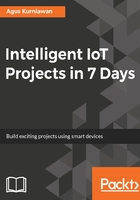
Introducing the PID controller
Proportional-integral-derivative (PID) control is the most common control algorithm used in the industry and has been universally accepted in industrial control. The basic idea behind a PID controller is to read a sensor and then compute the desired actuator output by calculating proportional, integral, and derivative responses and summing those three components to compute the output. The design of a general PID controller is as follows:

Furthermore, a PID controller formula can be defined as follows:

![]() represents the coefficients for the proportional, integral, and derivative. These parameters are non-negative values. The variable
represents the coefficients for the proportional, integral, and derivative. These parameters are non-negative values. The variable ![]() represents the tracking error, the difference between the desired input value i and the actual output y. This error signal
represents the tracking error, the difference between the desired input value i and the actual output y. This error signal ![]() will be sent to the PID controller.
will be sent to the PID controller.